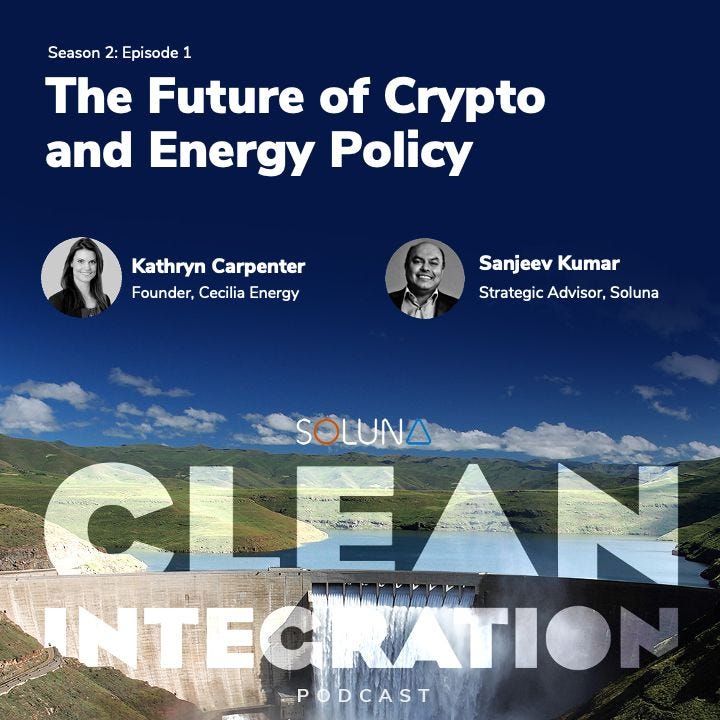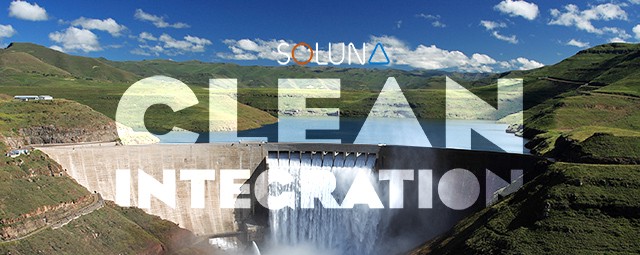Listen now on Apple | Spotify | SimpleCast
There’s a narrative out there that cryptocurrency mining is consuming massive amounts of energy and the industry could have negative impacts on the grid.
On January 20th, John was invited to testify at the House Oversight Subcommittee hearing called Cleaning up Crypto: The Energy Impacts of Blockchains. During that hearing, our members of Congress were seeking information about the sector’s energy use.
On January 27th, Senator Elizabeth Warren sent a letter to the top six crypto companies, demanding information about their energy use and impacts. In his testimony, John relayed Soluna’s position, that crypto’s energy use is a feature, not a bug, and that Bitcoin mining and other batchable computing can create a solution by providing flexible load to the grid.
As the crypto industry scales up in the US, some lawmakers are questioning its environmental footprint and calling for oversight. But here at Soluna, we hold that the prevailing narrative is wrong.
CEO John Belizaire recently spoke to Sanjeev Kumar, an expert advisor in the renewable energy space, and Kathryn Carpenter, founder of Cecilia Energy, a green hydrogen startup, to discuss crypto energy policy.
In this conversation, we elucidate why we don’t see crypto as an environmental menace.
In fact, the right mix of incentives could turn the currency into a significant driver of renewable energy growth.
(This transcript has been edited and condensed for print.)
Lawmakers are ramping up pressure on Bitcoin miners who use fossil fuels to operate. In your opinion, is there a reasonable policy compromise that would increase pressure on the dirty energy mining companies and promote innovative practices of using renewable energy excess instead?
Sanjeev Kumar [2:01]: Look, the pressure on the miners to go green is increasing, with deeper ESG mandates, as well as the increasing use of energy. The government can accelerate this trend and encourage the adoption of renewables for the mining industry. The government has several tools in its tool chest that have been very successfully used in the past, which could be used to encourage the adoption of the mining and compute facilities within the renewable projects. It’s profitable, greener, and provides resiliency and flexibility to the grid.
John Belizaire: Could you give us some examples? You alluded to tools that the government has used in the past. What are those? Are there some that have been used in the renewable energy space?
Sanjeev Kumar: Indeed. So investment tax credit (ITC) and production tax credits (PTC) have been instrumental in the wider adoption of the wind and solar industry. The ITC and the PTC could be extended to include mining equipment, and that will encourage solar and wind developers to include data centers and crypto mining sites in their development plans. Other things that can be done are to lower the cost of capital to make financing more accessible. The DOE has very successfully used a loan guarantee program, for instance. There are also things that can be done at the local and state level with the utilities for demand management, where incentives can encourage a more resilient grid and flexibility to that grid.
John Belizaire [04:32]: During the hearing, there was a big debate about the difference between proof of work and proof of stake, two different protocols that have some real tension in the marketplace right now, right? One is perceived as not very energy efficient and one as more energy efficient in powering some of these new blockchains. What’s at stake in that debate, the tension that has been sort of brought into policy makers’ focus?
What’s at stake in the war between PoW and PoS?
Kathryn Carpenter: It was actually reassuring. Unlike the earlier Senate hearings, where there was a questioning of cryptocurrency as a whole, policymakers were approaching this debate with more of an open mind. Ultimately, it continues to be an educational process of why certain assets such as Bitcoin use proof of work and cannot use proof of stake to have the same benefits of the proof of work concept and mechanism.
So as far as what’s at stake, no pun intended, cryptocurrency is global. Policymakers are smart enough to know that if the US wants to retain any kind of dominance within this field, they’re going to need to embrace Bitcoin mining. Quite frankly, Bitcoin is too big for the US to take a firm stance that proof of work mining is completely prohibited because Bitcoin fundamentally can’t move to proof of stake and get the same network strength that proof of work offers.
If the US does apply restrictions, as we saw with the China miners, it means that the jobs and industry will go somewhere else, plain and simple. I take less of a knee-jerk reaction to their question of “Well, why can’t we just move to proof of stake versus proof of work? We’re seeing Ethereum do it” because it’s a natural question for those policymakers who are not involved on a daily basis in a very complicated new industry that they didn’t grow up around. Most of them are not a product of the digital age.
It’s an educational process, and I think they’re asking the right questions. It’s the industry’s role now to present the purpose that Bitcoin plays, specifically why they use the proof of work mechanism, the advantages it has, and the disadvantages if certain assets did move to the proof of stake concept because there are pros and cons of both. One of the cons of the proof of work is that it is energy-intensive, but there are ways to make it greener and still have those benefits. So as far as what is at stake, I really don’t see any scenario where policymakers take draconian action against proof of work mining. If it does happen, it would be very costly to the US.
John Belizaire: No, that’s a fantastic perspective. My two cents are very similar to yours in that the proof of work protocol has proven very effective in securing the asset over the course of 13 plus years. And Proof of Stake is a younger version if you will, and there are some concerns about how strong the security is.
Theoretically, it seems to be effective and is being proven on new platforms. So, the question is what would be the risk to pushing technology to make a change that isn’t based on any sort of real risk analysis, if you will. I agree also that it does have economic incentives in the system to continue to improve the efficiency of the energy use for the purpose that it serves.
If we think about why this is important, we really have to think about whether the crypto community has something they could rally around. It’s exciting that Congress has joined the conversation.
Do you think there is an aspect of this policy debate that the crypto community can rally around?
Sanjeev Kumar [9:07]: Look, crypto miners and other people in the ecosystem recognize that to fully realize the potential and value of Bitcoin and other currency mining, the green footprint, and energy usage have to be addressed.
We have to come up with scenarios where the interests of the miners and the overall benefits to the community are realized. We are seeing the freeze in Texas, for instance, and there is a big debate: what is going to happen to the grid? A lot of the crypto miners have actually shut down their production to provide more resiliency and greater flexibility to the grid.
The fact that Bitcoin is here to stay has to be addressed and appreciated by the folks in government, and then they have to work with the crypto community to say, how do we encourage the adoption of green energy and actually discourage the use of more traditional energy that has a higher carbon footprint? Those interests can be aligned. It can be mutually beneficial.
I keep coming back to the point of the resiliency of the grid. There’s a lot of work that is taking place today around this whole concept of a virtual power plant, using storage and then being able to control how the power is distributed. The mining center can become, and crypto mining can become, an integral part of that solution. There have to be incentives on both sides to say that crypto is here to stay. How do we now work together and incentivize using more solar and wind power and adopting batteries?
John Belizaire: So you’re saying that the community should really rally around the concept that our industry could actually be a catalyst for renewables. We’re a great solution to a big problem the space has, and that’s where you should put your focus?
Sanjeev Kumar: Absolutely. There is a lot of work being done on the hardware side, with power electronics, batteries, and a lot of software solutions that are being developed. Crypto mining can, if fully integrated into renewable projects, provide the solution that the grids have been looking for.
Kathryn Carpenter: First and foremost, the crypto community should rally around the simple fact that policymakers are aware of the pro-crypto age group and that they need to capture those voters when pushing for crypto legislation.
Both Democrats and Republicans are keenly aware that the younger generation has an affinity for crypto in the digital age, so it can’t be underestimated how important just having a voice is in driving policymakers who are writing these legislations and bills and just being the voice of their constituents. A lot of the areas that could be pushed by the crypto community will shape out on a bipartisan side, and pushing legislators to provide fair and clean guidance that allows crypto to thrive in the US is going to help the US become a global player in the crypto space.
The crypto community and miners not only should embrace the net-zero goal, as was mentioned earlier; the majority of the demographic is already on board with the fact that this solution does need to be green and held accountable. Having that kind of self-accountability within the industry is going to help keep the cost-effective renewable energy pushing forward into the crypto community, which already from its origin embraced the ESG metric. Crypto as an industry has a really good ESG angle. It’s not being overlaid retroactively, like in some industries; it was actually ingrained from the beginning. Rallying around, embracing, and continuing the purity of that rhetoric is going to be extremely important, especially when making policies.
Another huge area where there should be continued pressure from the community is making sure that there’s not a change in the law. The worst thing that could happen is retroactive regulatory changes. Clarity and clear guidance are what are going to continue to bring more institutional money in and really help drive the industry forward. It would be disastrous on so many fronts: cost jobs and billions of dollars to the industry and hurt the faith of constituents in the US. I think it’s unlikely that will happen, but the community must push to make sure that there’s clear guidance and no retroactive policy changes. Regulation doesn’t kill markets, but uncertainty can.
John Belizaire: There was a comment you made in one of our conversations recently that the more the government gets involved and provides support for the industry, and the less it introduces laws that retroactively introduce risk to the industry, the greater the industry’s ability to connect to and partner with renewable energy projects. Do you still have that perspective?
Kathryn Carpenter [16:15]: I absolutely do. There needs to be a partnership. Everyone should be held accountable for that net-zero carbon goal; energy policy is going to be key, and the legislature that pushes the industry to act how they want them to act is going to be critical. It’s interesting because the US has a two-tier policy system on the regulatory front. There’s the federal level, yet especially on the renewable side a lot of people don’t realize that the states actually decide a lot of their renewable portfolio standards. So there’s no doubt going to be a lot of individual regulations throughout the US. And we’re going to see a bit of differentiation, as we did with the renewable industry before, specifically with the mining industry as far as policy making goes.

What do you think will happen next on the policy front? What do you think Congress does next?
Sanjeev Kumar: Well, President Biden’s target of carbon neutrality by 2050 will require some significant actions and legislation. Most importantly, some form of Build Back Better where renewable energy and green sustainability are a focus. I hope some form of compromise takes place there. Embedded in there are some very important provisions, like the extension of the investment tax credit, providing tax credits to battery storage technology on a standard loan basis that are going to be very critical to coming up with some completely off-grid solutions that we talked about, and encouraging the infrastructure investors to come in. The point about consistent policies is really important.
We saw what happened in the solar industry. I got involved in the solar industry almost 15 years ago when Italy and Spain changed their policies retroactively. They literally killed the industry for a while; it kept the investors away. We need bigger long-only investors, infrastructure investors, to come into the sector, have faith in the sector, and put the money needed for the longer term in the sector. The policies that encourage that investment and provide the rate of return that the investors want is going to be really important. One ongoing aspect of the volatility in the renewable industry will be government policy, narrative, and support. The time for that is now.
Kathryn Carpenter: I think there’s going to be some sort of global rebranding of cryptocurrency, just because “currency” is a bit of a misnomer. But the US government has the ability to get the tax revenue and an economic job boost from this new space, so
I think that [on the policy front] it’s going to be positive. One area that they’re likely going to address first is concerns that they don’t want to destabilize the dollar or mess with fiscal policy, particularly KYC or AML-type policy. I think the legislation that they’re going to try to tackle first is in the DeFi space, knowing customer and anti-money laundering requirements are going to be the highest policy priorities.
Followed by that, I think they’ll tackle energy policies associated with proof of work mining. That’s going to take a bit longer, though. As a career renewables individual, I’m obviously in the camp that all uses of coal and fossil fuels should be reduced to zero as we get to our net-zero economy. That should be at the forefront of the mind of the Bitcoin mining industry, or proof of work mining industry. That’s the case for all energy consumers, not just this industry. It’ll be easier to fold into the policies once they are made if it’s addressed from the start.
And as briefly touched on before, it’s important to remember that the US is double-layered in its renewable energy policy. There’s the federal level with the investment tax credit, but the state legislature controls the RPS. Really, the biggest tool that the federal government has at their level is the ability to push the incentive mechanisms in the way of tax credits or flexible load credits at the grid level to incentivize the use of renewables in the mining space.
Rather than an ITC, we’re more likely to see them go to grid-level flexibility, as that is such a critical issue right now in the US, and that’s at the FERC level. There is a way for federal policy to actually address that, which is outside of the state-level policy control. That’s where I see it going as far as the order of operations and what they’re going to address first and where.
John Belizaire: On the grid level, are you alluding to policy at the federal level that would encourage the grid to have a certain level of flexibility?
Kathryn Carpenter: That’s right. Essentially like batteries are doing: being able to turn off in times of peak demand and utilize power, or turn up the operations when there’s less demand and an over-abundance of renewable energy, which is a significant issue on the stability of the grid in many states.
John Belizaire [22:45]: Well, thank you both. That’s a very, very insightful take on a very interesting dialogue that is taking place between the young and fast-maturing crypto industry and the seats of government, thinking about what to do about energy policy going forward, investments and infrastructure, build-outs. It’s a very interesting confluence of things happening. We’ll have to see what happens next.




